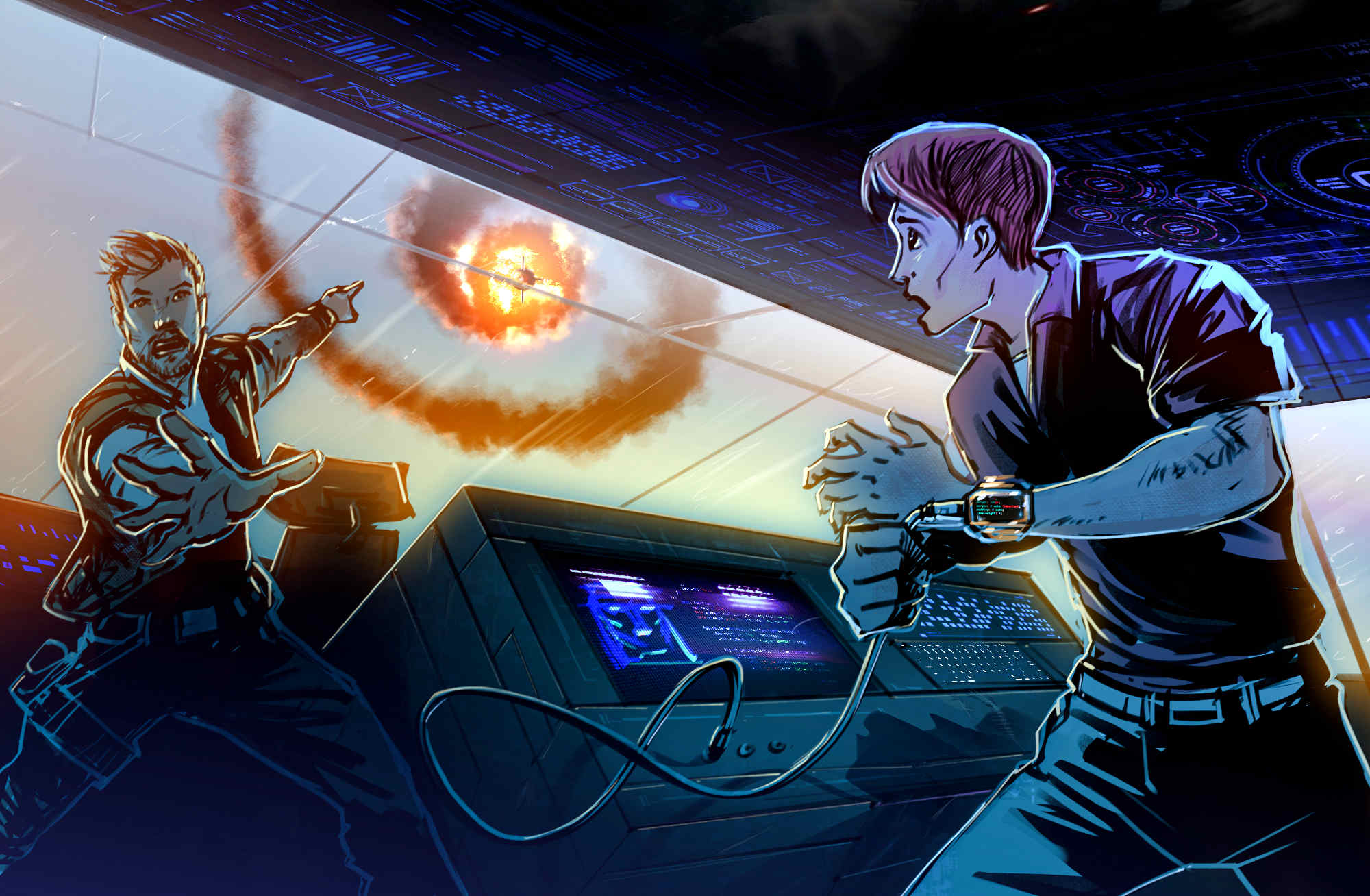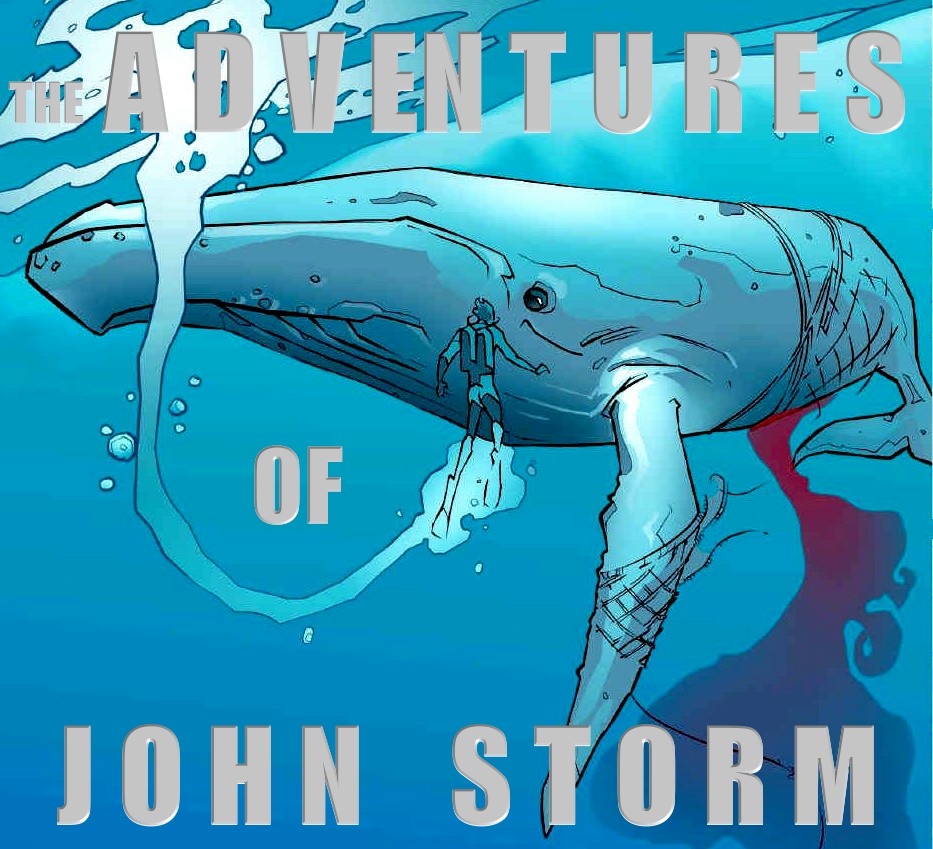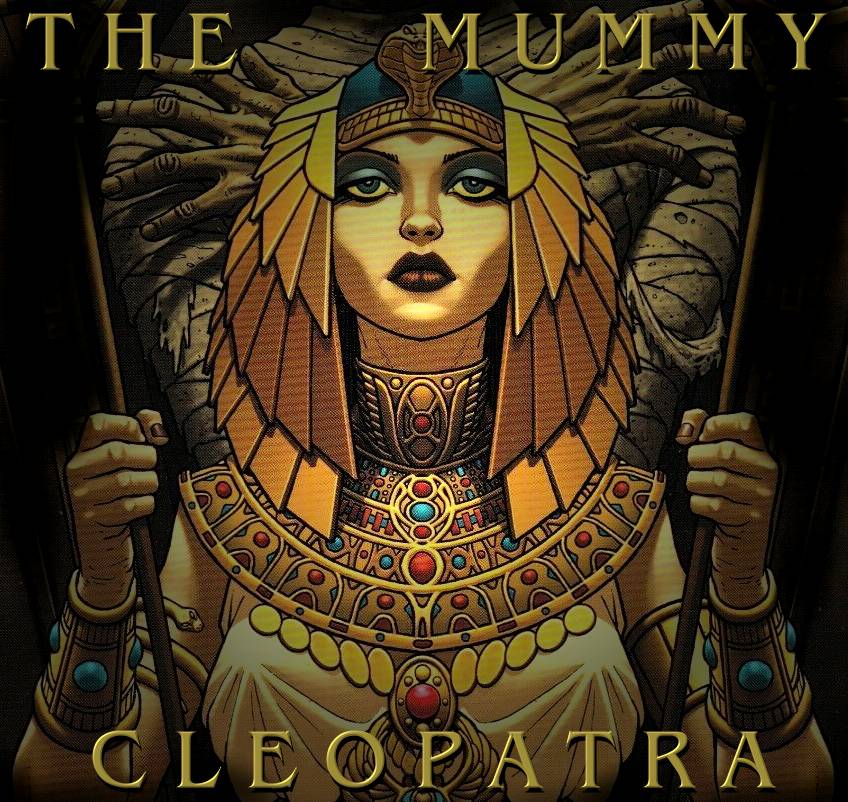|

American heroes from Marvel comics have dominated the genre for decades, while other countries' iconic spandex-wearing vigilantes rarely get the same love. Britain especially hasn't been that well-represented in the
MCU or DCU. I's not like there isn't a wealth of British heroes for Marvel Studios to use, though, and it's only a matter of time before they get their cinematic debut.
John
Storm is a new breed of British super hero outside the MCU/DCU. Seen here with Dan Hawk, at the helm of the Elizabeth
Swann. The formidable high tech duo discover they have
no way to make it in the book or film world, but soon realised that they make
excellent comic characters, ideal for publication as graphic novels. George
Franks, mentor, is held to be a descendant of the legendary King Arthur, a knight of the
fabled Round Table, though unable to prove the fabled meeting place ever
existed at all. Hal combined with the CyberCore technology, is seen by many
as a modern Merlin. As is the ship's weapons systems, including a high powered laser
named Excalibur, and anti pirate tazer named Pendragon.
The
UK is markedly under represented in the super hero genre. Arguably, James Bond
(not a true superhero) only survived on his gadgets with the franchise
struggling, as a remnant of the chivalrous Medieval Knights of old, the
original combat superstars, such as Lancelot and the legendary King Arthur.
Robin Hood, also comes under this banner, armed with his unnatural ability
with a bow and arrow. A kind of super ability. Yet, Hollywood might only
regurgitate a 'Robin Hood' movie once every ten years on average, as a new
actor presents, who might carry the brand through to favourable box office
returns. Whereas, tales of knights in shining armour, are simply not good
investments. To wit, returns on Taron Egerton's reported loss of $13.5
million dollars in 2018, with Robin Hood. ($100m budget - $86.5m box office)
and disappointing returns on the 2010 Robin Hood film with Russell Crowe
($237m budget Vs $321m box office), even though directed by Ridley Scott.
Whereas, in 1991, 'Robin Hood Prince of Thieves,' starring Kevin Kostner,
made a whopping $342m dollars ($48 budget Vs $390m box office) helped by a
superb theme song by Bryan Adams.
The
pattern is plain. A Robin Hood film, roughly every 10 years, with dwindling
returns - not being a good investment. And, we love the Robin Hood story.
Put
simply, DC
and Marvel
comics have changed the movie landscape. Kids brought up on these kinds of
mind-blowing special effects where every actor is muscle bound, will not sit
still for anything less. Living in an instant push-button world of gaming,
where everything is exaggerated.
John
Storm is a hybrid character. A new breed of modern Knight, fighting to protect the
natural world and the archaeology that defines man's development, from
Tanzania, to the Moon and beyond. Storm's ace in the hole is the Elizabeth
Swann, the onboard
AI, Hal, and his enhanced performance via a brain implant and genetic
modification. Thus, just about keeping pace with what the market expects in
a modern world: A technological super secret agent. In this case, for Blue
Shield & UNESCO.

THE
FIRST SUPER STARS - KNIGHTS IN SHINING ARMOUR, STEEDS AND SWORDS
The
origin of Knights, from the Middle Ages, hark back to the fall of the Roman Empire in western Europe whose last emperor, Romulus Augustulus, was toppled by a Germanic warlord in A.D. 476. The vacuum left
by the destruction of Rome
was partially filled by the Roman Catholic
Church, and also by relationships between the church and the dominant local lords.
Europe's medieval period lasted from the fall of Rome in the 5th century to the spread of the Renaissance in the 15th century. In this time, the pope
(head of the Catholic Church) became one of the most powerful figures in Europe.
The
Church supported the Lords, in part by anointing Kings and Lords as God’s chosen rulers, but also controlled them through fear of cutting off God’s approval through interdict and excommunication.
Over time, this led to and supported the rise of feudalism, a system dependent on knights to support the
King of the realm, and in turn, the church, and a way for society to recruit
their knights.
THE
FEUDAL SYSTEM
The feudal system was based on a complex web of rights and obligations among rulers, nobles, serfs, peasants, and freemen. With little or no commerce, land and its produce were the only forms of wealth and, with it, power. Each feudal lord held sway over his land grant and its people. Over time, feudalism was built on the uniformity that had been previously imposed by the Roman Empire.
Due to a preexisting warrior culture, knights became exalted superstars. They were the product of long training in both military skills and spiritual and societal matters. What bound knights together as a social group was a detailed code of values, behaviour, and accomplishments, including courtesy, refinement, honesty, largesse, and gallantry. Becoming a knight certainly meant developing skills of combat and the use of arms, but it also entailed hunting, learning to read, and playing games like chess.
Knightly ideals can be grouped into three strands: noble birth, Christian values, and military prowess. Literature about knights, such as those of the legendary
King Arthur and his court, became popular and would have a profound influence on the origins of the European novel. The importance of chivalric culture in storytelling persists today through its extensive use in fantasy fiction and fandom, gaming, animation, television shows, and movies.
One way to truly understand the nature of knighthood in this period is to meet some of the knights themselves, whether historical figures like Richard the Lionheart, or literary ones. In fact, the line between historical record and literary invention is often blurred. Literary models influenced the behaviour of real knights, while real knights offered abundant material for writers of literary accounts.
Such as: Charlemagne, El Cid, Orlando, Pope Joan, Melusine, Merlin the Wizard, and also the fox and the unicorn.
THE SWAN KNIGHT: GODFREY OF BOUILLON
One of the earliest and most representative examples of a chivalrous knight was Godfrey of Bouillon (circa 1060-1100). After the 14th century, he was included among the so-called Nine Worthies: nine men through the ages (some historical, others legendary) deemed to have embodied the ideals of chivalry.
Godfrey was the son of Count Eustace II of Boulogne and Ida of Lorraine, and together with his brothers helped lead the First Crusade in 1096. Godfrey’s fame and prestige among the diverse group of barons commanding the Crusade grew so that, when the crusaders succeeded in reclaiming Jerusalem from Islamic rule in 1099, they offered Godfrey the throne of the new kingdom of Jerusalem. Godfrey, in a gesture that ticked all the chivalric boxes, refused and piously argued that no one should wear a golden crown in the city where Christ had worn the crown of thorns. Instead, he agreed to be called the Defender of the Holy Sepulcher.
Godfrey was such an exemplary knight that he became legendary. Embellished tales were written about his journey to the Holy Land and established his noble lineage. The best known of these stories is the legend of the Knight of the Swan; originally, itruc was the tale of an anonymous knight who appears in a boat drawn by a swan to rescue a damsel in distress. By the end of the 12th century, popular tellings identified the protagonist with the Bouillon dynasty and claimed that the mysterious Knight of the Swan was none other than Godfrey’s grandfather. It was a story that wove together fact and fiction around the figure of one of the most recognised knights of Christendom. This mixture of literary evocation, embellishment of reality, and celebration of chivalric values developed over a long period in medieval Europe, and especially in the Anglo-French world.
THE TOURNAMENT MASTER: SIR WILLIAM MARSHAL
One knight who was well known in both France and England was William Marshal (circa 1146- 1219). He served as royal adviser to four English kings: Henry II, Richard I (popularly known as the Lionheart), John, and Henry III. Even members of the French court grudgingly acknowledged that he was the best knight in the world. William guided these four kings wisely through numerous crises and dangers, making his name synonymous with the model of the chivalric virtues of his time.
The details of Marshal’s life have been preserved in a literary account commissioned by one of his sons, L’histoire de Guillaume le Maréchal, written in Old French verse. Its lines chart Marshal’s meteoric career, from leaving his father’s house to train as a knight (as a second son, this path was expected) to the final hours of his life. Although Marshal was no ordinary knight, the account does offer much insight into what life was like for knights in general at the time. There is a description of Marshal’s training in the house of the powerful Norman nobleman Guillaume de Tancarville, who was his mother’s uncle; his investiture as a knight in 1166; and his first military campaign.
Soon, young Marshal would find an activity that would shape his life and become a true passion: the tournament. These contests were far more brutal than the folk pageant versions celebrated today: more like battles than games. Young knights took part, either individually or in teams, hoping for a chance to demonstrate their fighting prowess and perhaps win themselves fame and fortune.
During the late 1100s, tournaments were enjoying their heyday, and Marshal excelled at the jousts. For more than a decade, he was said to have unhorsed and captured more than 500 combatants as he went from tournament to tournament. Defeated knights would have to pay a ransom. Together with the spoils from seizing harnesses and saddles, Marshal could enjoy a highly valued chivalric practice: largesse. Generosity in distributing the bounty from his wins allowed him to forge valuable loyalties.
As well as excelling on the tournament field, Marshal acted as master of arms and confidant to Prince Henry, son of Henry II of England and heir to the throne. The young prince died before he could wear the crown, and William fulfilled the promise he had made to him to travel to the Holy Land, where he fought for two years alongside the Templars. When Marshal returned, the king offered him the hand of Isabel de Clare, Countess of Pembroke, one of the wealthiest heiresses in the kingdom. The union raised Marshal to the highest ranks of the nobility. His days as a knight-errant were over.
Marshal would continue to shine on the battlefields. When Richard the Lionheart was away on the Third Crusade, William protected his throne against the manoeuvring of John Lackland, the king’s brother and regent. After Richard’s death, when the same John’s right to the throne was in dispute, Marshal was one of the few great nobles to remain on John’s side during the First Barons’ War, in which the nobility rebelled and forced King John to issue the charter of rights known as Magna Carta.
This uncompromising loyalty to the crown sealed William Marshal’s reputation as the greatest knight of his time. He died shortly after his last great military victory, the Battle of Lincoln, in 1217, where he succeeded in driving the French army out of England, and forcing the French king to give up his claim to the English throne.
THE END OF CHIVALRY
The English longbows and trained archers combined to bring victory at Agincourt, along with the tactics of sneak-attack cavalry charges and defensive manoeuvres of massed, un-knighted foot soldiers. Longbows and new tactics led to killing an enemy at a distance. Black powder
firearms - long-barrelled arquebuses, muskets, and pistols - came on the scene in the late 1400s, further changing combat. Knights had fought face-to-face with their foes for so long and considered doing so a mark of honour, but these changes made their suits of armour and methods of combat seem outdated.
Systemic changes also hastened the decline of knights. Monarchs grew stronger and were able to develop more modern institutions to collect taxes, create courts of law, and fund standing armies. Distance grew between the church and the state as both competed for power and influence across western Europe.
The knightly world created by feudalism, with its articulated values of nobility, an ingrained social and religious order, and a courtly code of conduct, was shaken to its foundation by these developments. The new world order,
centered on a powerful monarchy and its administrators, radically altered their support system, livelihood, beliefs, and the very society that had created them. The age of chivalry was over, but the lives and legends of these medieval men would endure for centuries.
COMIC
BRITISH SUPER HEROES - A TO Z
Black
Knight, Dane Whitman (British, American, Ebony Blade Cursed Sword
Strong, Marvel)
Blade, Eric Brooks (Vampire Hunter Born Soho, London MI-13* [Wesley Snipes] British SuperHero,
Marvel)
Captain Avalon, Brian Braddock (Protects mystical Omniverse, Britain Corps,
Excalibur, Marvel)
Captain Midlands,
'Rambling' Sid Ridley (British Army Super Soldier Program MI-13*)
Dark
Angel, Shevaun Haldane (Psylocke, British Superhero Darkmoor, England,
Marvel Comics)
Dr Druid, Anthony Ludgate (Raised England, studied magic Harvard Medical Degree,
British Superhero)
Dr. Faiza Hussain (England, London - Sword Of Arthur
Excalibur Stone [Marvel Disney])
Elsa
Bloodstone, Monster Hunter (Marvel Comics)
Elizabeth 'Betsy' Braddock (Super heroine Captain Britain, mutant Psylocke Amulet of Right
Excalibur Knights)
John
Storm - Storm Force, ex army captain, soldier turned mercenary with
cybernetic arm 1987 Eagle comics
Ka-Zar,
Lord Kevin Plunder (British Royal Heritage England [Tarzan] Raised By Mutant Sabretooth Tiger
Zabu)
Motormouth and Killpower Harley Davis & Julius Mullarkey, Marvel UK Stories British Super Heroes
Mys-Tech Organization
Pete Wisdom (British Secret Agent Mutant Mi-13*
Excalibur X-Force S.T.R.I.K.E.)
Spider-Woman, Jessica Drew (London, England - Avengers Hydra
S.H.I.E.LD British
Superhero, Marvel)
Spitfire, Lady Jacqueline Falsworth Crichton (Vampiric Speedster Marvel Comics,
Immortal MI-13*)
Union Jack, Joseph 'Joey' Chapman (Patriotic Legacy Hero World War One [Liverpool, England] Marvel)
*
Military
Intelligence, Section 13 (MI-13), is the United Kingdom's (fictional) agency set up to deal with paranormal occurrences and is part of its intelligence machinery alongside MI5,
MI6, GCHQ, and DI. MI13 is directed by the JIC (Joint Intelligence Committee). The service is directed to protect Britain from mystical, extra-terrestrial and superhuman threats.
MARVEL
COMICS US SUPERHEROES - A TO Z
Ant
Man,
Captain
America,
Doctor
Strange,
Hulk,
Iron
Man,
Spider-Man,
Thor, and
Wolverine,
HISTORICAL
SUPER HERO KNIGHTS IN ARMOUR & LEGENDS
The knights of medieval Europe were meant to be the finest fighting men of their age, even more important, they were expected to be pure in thought and deed, as exemplified in the chivalrous code which they (usually) followed.
Use the links below to follow the story of 12 such knights. Most of the legendary figures
above are based on historical knights and the historical knights have become
legends over time; such is the indistinct line of truth between fact and fiction and humanity's need to create larger-than-life figures of a by-gone age when valour and chivalry reached their apex.
If only such codes existed in politics today. Or, you might argue, that due
to the high level of corruption recognised by the United
Nations as unsustainable, we need a modern breed of knight. We need John
Storm.
MYTHICAL
HISTORICAL LEGENDS
Saint George is based on a soldier in the Roman army who was martyred in 303 CE (Patron saint of knights)
Sir Galahad - Knight of the Round Table 12-15th century CE literature (King
Arthur legend)
Siegfried - Brunhilde & King Gunter (Kriemhild, Burgundian [Nibelung] princess) c. 1200 CE
RECORDED HISTORICAL KNIGHTS
Robert
Guiscard - 'The Crafty' (c. 1015-1085 CE) [Norman]
Rodrigo
Díaz de Vivar - 'El Cid' (1043-1099 CE)
Godfrey
of Bouillon (circa 1060-1100)
Sir William Marshal - 'The Greatest Knight that Ever Lived' (c. 1146-1219
CE)
Richard I - 'The Lionhearted' (1157-1199 CE) King of England from 1189 to
1199 CE
Sir William Wallace (c. 1270-1305 CE)
Sir James Douglas - 'The Black Douglas' (c. 1286-1330 CE)
Bertrand du Guesclin - 'The Eagle of Brittany' (c. 1320-1380 CE)
Edward
of Woodstock - 'The Black Prince [of Wales]' (1330-1376 CE)
Sir
Henry Percy - 'Hotspur' (1364-1403 CE)




|

